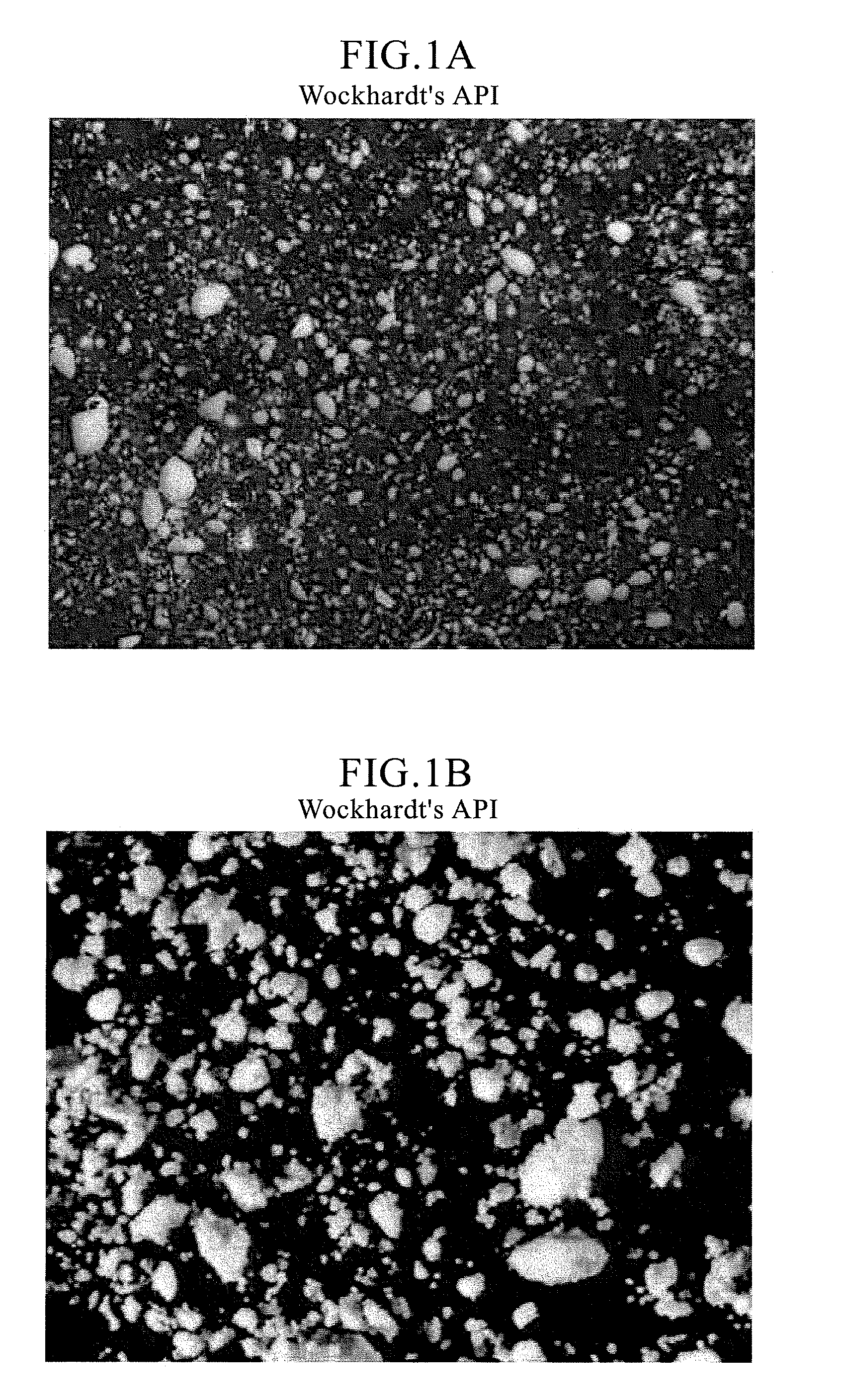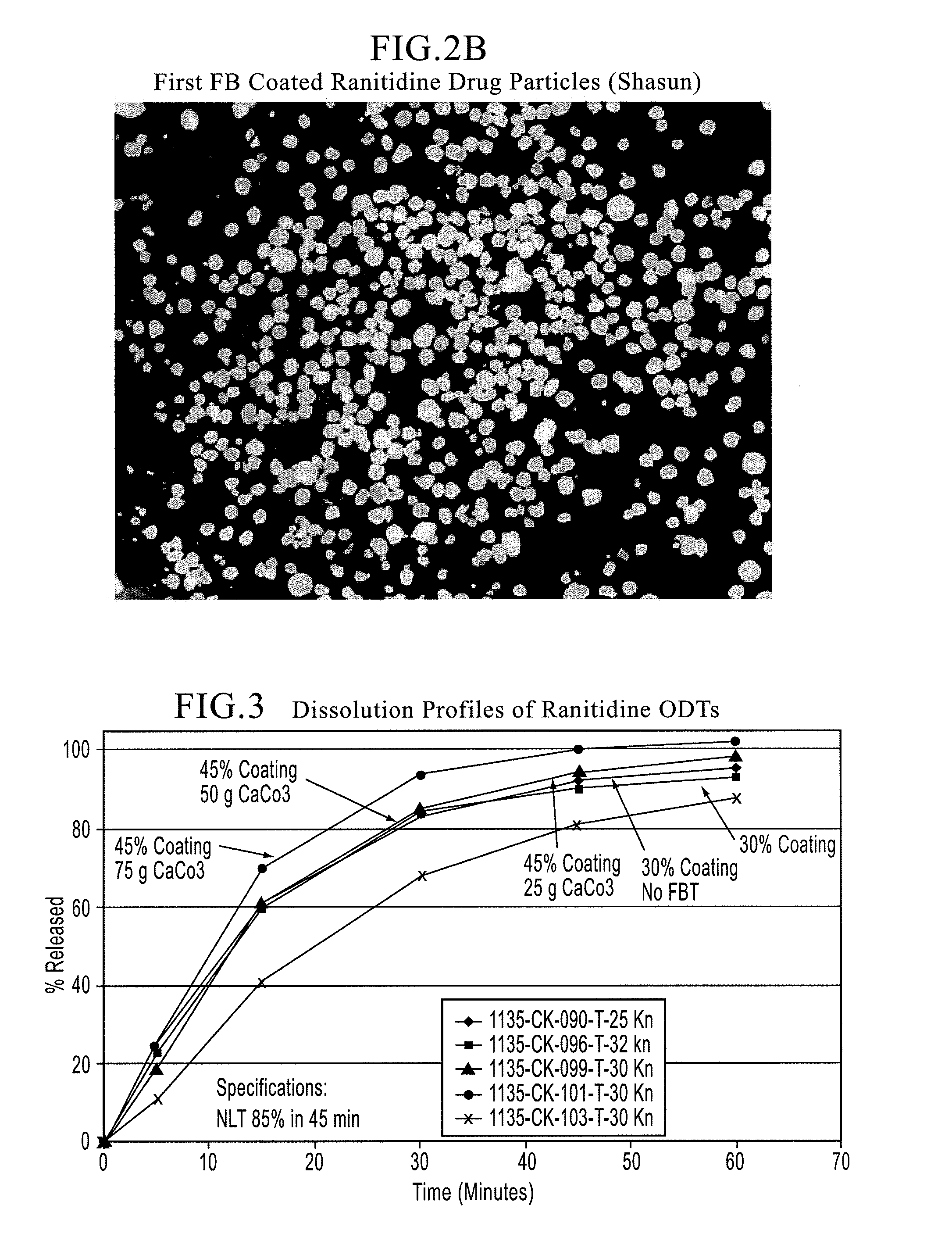Orally disintegrating tablet compositions of ranitidine and methods of manufacture
- Summary
- Abstract
- Description
- Claims
- Application Information
AI Technical Summary
Benefits of technology
Problems solved by technology
Method used
Image
Examples
example 1
[0106]As is apparent from FIG. 1 that shows the micrographs of Ranitidine hydrochloride (form II) drug substance from two of many API manufacturers, the drug substance has typically a significantly wider particle size distribution, as well as a wider aspect ratio (ratio of major axis to minor axis). Consequently, it is difficult to effectively taste-mask these drug particles by coacervation, and / or by fluid-bed coating and incorporate the microcapsules thus obtained into an ODT (orally disintegrating tablet) expecting it to disintegrate on contact with the saliva in the oral cavity into a smooth easy-to-swallow suspension with a non-gritty mouthfeel and no aftertaste.
[0107]1.A Ranitidine hydrochloride microgranules: 49 parts of ranitidine hydrochloride drug substance with a mean particle size of 12-16 μm (Polymorph Form II from Vera Laboratories) was blended with 45 parts of mannitol and 5 parts of hypromellose (Methocel Premium 400 cps from Dow Chemicals) in a high shear granulator...
example 2
[0111]2.A Microcapsules of Ranitidine Hydrochloride: Ranitidine hydrochloride (Form II from Shasun Drugs and Chemicals) with desired particle size specifications (e.g., NMT 5% retained on 35 mesh (500 μm) and NMT 10% passing through 270 mesh (70 μm)) and average aspect ratio specification of NMT about 3 (see FIG. 2A for micrographs of the drug substance), Ethocel Premium and Epolene were charged into the 4L coacervation tank (see Table 1 for compositions of Microcapsules lots #1135-005 at 45% ethylcellulose coating and 1135-027 at 30% ethylcellulose coating) and were taste-masked in accordance with the disclosures of Example 1.B above. During the microencapsulation of Microcapsules lots# 921-190 and 1135-050, micronized calcium carbonate, a pore-former was added into the coacervation tank upon reaching the product temperature of approximately 58° C. while mixing to achieve a uniform distribution of the pore-former throughout the ethylcellulose membrane. Apart from this step, the pro...
example 3
[0116]3.A First Polymeric Membrane by Coacervation: Ranitidine HCl (Form II) drug particles from Shasun (1100 g) were charged into the 5-gallon system along with Ethocel 100 cps (194.1 g) and Epolene (100 g) and microencapsulated for a coating of 15% by weight while mixing at the speed of 150 RPM in accordance with the disclosures above. Several lots of Microcapsules with said coacervated polymeric membrane were prepared under the same processing conditions. FIG. 4.A shows the micrographs of typical microcapsules produced by solvent coacervation.
[0117]3.B Second Water-insoluble-Gastrosoluble Polymeric Blend Membrane: Said coacervated drug particles from above were coated with a water-insoluble ethylcellulose (Ethocel Premium with a viscosity of 10 cps) and a gastrosoluble Eudragit E100 polymer (see Table 3 for compositions of the microcapsules) dissolved in 95 / 5 acetone / purified water in Glatt GPCG 3 equipped with a bottom spray Wurster insert under the following conditions:—port si...
PUM
| Property | Measurement | Unit |
|---|---|---|
| Fraction | aaaaa | aaaaa |
| Fraction | aaaaa | aaaaa |
| Fraction | aaaaa | aaaaa |
Abstract
Description
Claims
Application Information
 Login to View More
Login to View More - R&D
- Intellectual Property
- Life Sciences
- Materials
- Tech Scout
- Unparalleled Data Quality
- Higher Quality Content
- 60% Fewer Hallucinations
Browse by: Latest US Patents, China's latest patents, Technical Efficacy Thesaurus, Application Domain, Technology Topic, Popular Technical Reports.
© 2025 PatSnap. All rights reserved.Legal|Privacy policy|Modern Slavery Act Transparency Statement|Sitemap|About US| Contact US: help@patsnap.com



